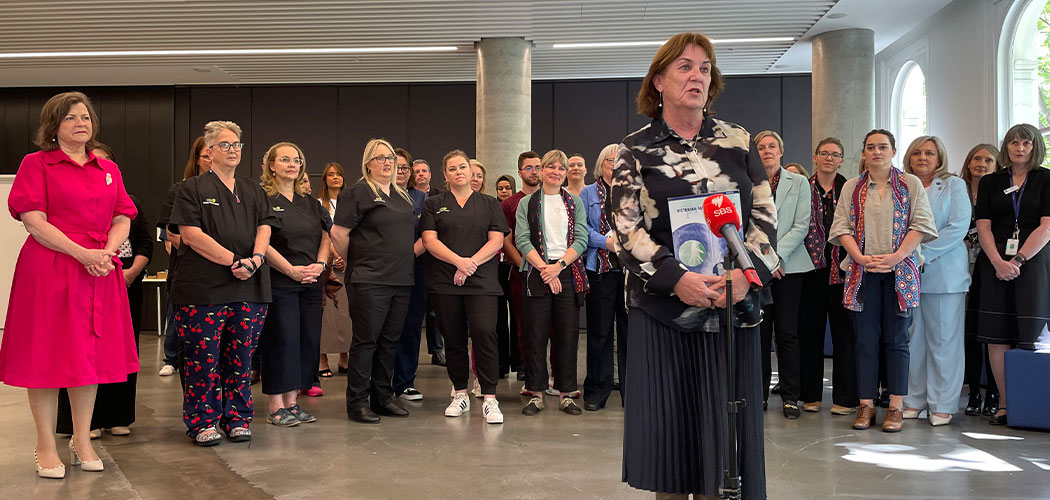From this Friday, nurse practitioners and endorsed midwives will finally be able to work to their full scope of practice thanks to the removal of restrictive ‘collaborative arrangements’.
Legislation introduced by Assistant Minister for Health and Aged Care, Ged Kearney, which passed through the Parliament in May, comes into effect on 1 November. It will enable nurse practitioners and endorsed midwives to provide a range of Medicare services and prescribe certain Pharmaceutical Benefits Schedule (PBS) medications, in line with their skills and experience, without unnecessary barriers.
Since gaining access to provide Medicare services and prescribe PBS medicines in 2010, NPs and endorsed midwives have been legally required to have a “collaborative arrangement” with a medical practitioner. This involved having to rely on the availability and willingness of doctors to enter into them.
Marking the reform at a press conference in Melbourne this morning, Assistant Minister Kearney said for many years, NPs and endorsed midwives have been held back from working to their full scope and providing the best care because of “red tape” that has stymied their practice.
“This [legislation] really opens up the doors for endorsed midwives and nurse practitioners to operate independently, to set up their own small businesses, to provide very best care to the community that we possibly can,” Ms Kearney said.
According to the Government, review after review found that patients benefit from the high-quality care that endorsed midwives and nurse practitioners provide, particularly in rural and regional communities that struggle to attract and retain doctors, either full-time or long-term.
Leanne Boase, CEO of the Australian College of Nurse Practitioners (ACNP), said the removal of collaborative arrangements was crucial. It will enable more people to access funding and subsidies for their healthcare and improve the affordability of care provided by nurse practitioners.
“It is about nurse practitioners and endorsed midwives, but it is also about people accessing healthcare, and that’s why we’ve been fighting for this for a very long time,” she explained.
“They will have access to the entitlements that they already pay for through the tax system. They will have access, particularly people who are struggling to access healthcare, will have better rebates, Medicare rebates available and more medicines will be subsidised.
“Nurse practitioners will continue to work in the same way from 1 November, delivering the same collaborative and person-centred care, however this will reduce the administrative burden for many, allowing them to focus more time on healthcare.”

ANMF (Vic Branch) Secretary Lisa Fitzpatrick, who brought along the original 1999 report from Victoria regarding the commencement of the nurse practitioner model, said the changes were a testament to the collective strength and determination of nurses, midwives and key stakeholders, such as the ANMF and ACNP.
“We do need to make sure that we have not just sufficient numbers and growing numbers, which we do have, which is wonderful, but of course we need the opportunity for these wonderful skilled nurses and midwives to be employed, as well as those who choose to commence their own business.”
ANMF Federal Secretary Annie Butler said the union, along with other national nursing and midwifery peaks, had worked tirelessly over the past 14 years to advocate for the removal of the outdated arrangements to ensure people get better access to quality healthcare.
“This is a big win for NPs and endorsed midwives and the people they care for and support in the community,” Ms Butler said.
“The requirement for a ‘collaborative arrangement’ was never about clinical supervision or clinical collaboration, but access to payments and funding under the PBS and Medicare. That’s why removing these barriers will finally allow highly-qualified NPs and endorsed midwives to work autonomously to their full scope, providing people with better access to quality care without the need to visit a GP surgery or wait in a crowded hospital ED.”









8 Responses
Well done. Keep the momentum going
Excellent .does this mean that midwives can also do hospital deliveries.?
I’m retired now but when I first came to Australia I was surprised that doctors were called for all deliveries. In Scotland we called the doctor if there was a problem. Re home births. We had the flying Squad which was an ambulance fully fitted out for obstetric emergencies plus experienced obstetric staff. I hope that will be taken into account for home deliveries
I’m sure there are rule’s and regulations about home births. Some mothers must have a hospital delivery
Yes Dorothy That was what I found when I came to Australia in the 60s, a bit of a surprise it was to say the least. enjoyed my mid training then but was saddened that women did not have the choice to deliver at home here and had to be abide the rigidly enforced “rules” of the hospital delivery. Thankfully over time we have moved on from that scenario and a range of choices for women are available with safety provisos extablished. I
About time.
Wouldn’t it be nice if they had a 15% pay increase as well!
Well overdue particularly in rural & regional areas 💫
Fantastic win for nurse practitioners
Absolutely brilliant and long overdue. Congratulations on your hard work 👏👏👏